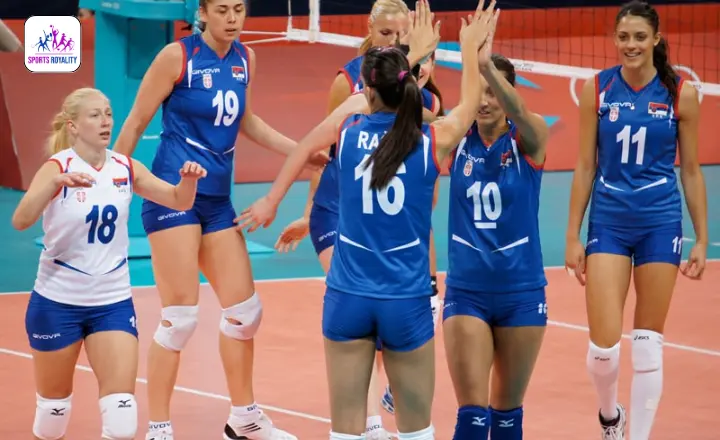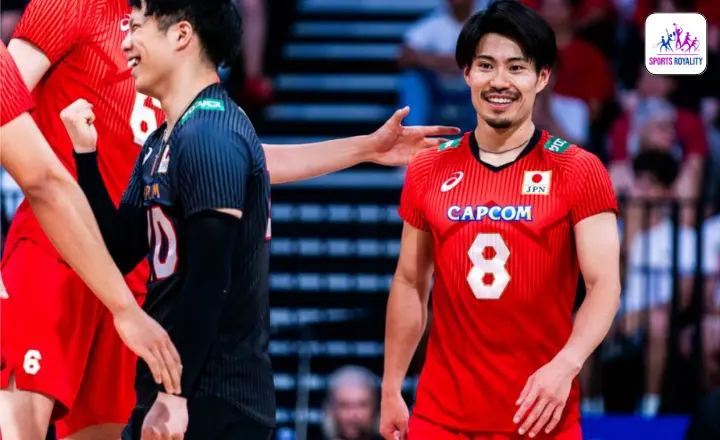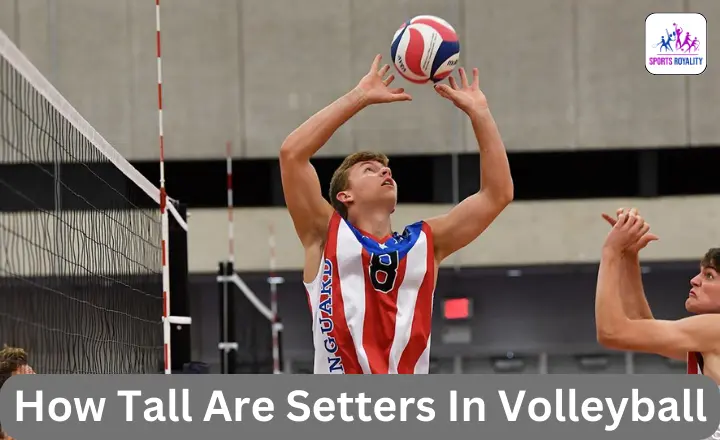A sport known for its fast-paced action and exhilarating spikes requires diverse player positions, each with unique physical attributes. Among these is the vital role of the setter, whose precise and strategic ball placement can make or break a team’s offensive attack.
Curiosity often arises as to whether height plays a significant factor in this position’s effectiveness. How tall are setters in volleyball? Becomes an intriguing question that unravels fascinating insights into the world of volleyball and sheds light on the importance of skill over stature in this dynamic sport.
So, let’s dive in and discover just how tall are setters in volleyball!
What Is The Average Height Of A Setter?
No set number applies to all levels of play. What is truly intriguing is how their height compares to other positions on the court. In professional volleyball, for instance, setters tend to be shorter than middle blockers or outside hitters. It might seem counterintuitive since setters are responsible for distributing the ball and making plays happen. But their smaller stature works to their advantage, allowing them to move quickly and enhance their agility.

Average Height Of A Setter Vs Other Positions:
The average height of a setter compared to other positions in volleyball is generally slightly shorter than outside hitters. According to data from the 2012 Olympics, setters were 2cm shorter than outside hitters on average. They still tend to be significantly taller than liberos, with a difference of approximately 10cm height.
It is interesting to note that setters are closer in height to hitters than liberos. They could be attributed to the role and responsibilities of each position. Setters often need good height and reach to effectively set the ball for their teammates, while hitters also require height for powerful attacks at the net. Liberos are typically specialized defensive players who focus on quick movements and agility rather than height.
Average Setter Height In The Olympics:
The average height of Olympic men’s volleyball setters has decreased slightly over the years. In 2012, the top 4 men’s teams had an average setter height of 195cm, but in the 2020 Olympics, it was recorded at 189cm. They could be due to various factors, such as changes in playing style or the emergence of shorter players with exceptional skills.
On the other hand, there is a noticeable trend of increasing height for women’s volleyball setters. In 2012, the top 4 women’s teams had an average setter height of 173cm, but in the 2021 Nations League, it increased to almost 181cm. They could be attributed to advancements in training methods and techniques that have allowed taller players to excel in this position.
It is important to note that these statistics represent averages, and there will always be exceptions to the rule. What matters most is a player’s skill set and ability to set up plays for their team regardless of height effectively.

Average Setter Height In College Volleyball:
According to the NCSA website, Below I discuss the average height for men’s and women’s college volleyball setters.
- D1 and D2: height range is 6’1 to 6’5 (185.5cm to 196cm).
- D2 and D3: The height range is 6′ to 6’4 (183cm to 193cm).
- D3 and NAIA: The height range is 6′ to 6’3 (183cm to 190.5cm).
- NAIA and CCCAA: height range is 6′ to 6’5 (183cm to 196cm).
Women’s college setter’s average height differs across divisions
- Division 1: Setters average height is 5’10 (178cm)
- Division 2: Setters average height 5’8 (173cm)
- Division 3: Setters average height 5’7 (170cm)
- Division NAIA: Setters average height is 5’7 (170cm)
Does A Volleyball Setter Really Need To Be Tall?
The height of a volleyball setter is not the sole determining factor of their effectiveness.
Height Is Extremely Underrated For A Setter:
Your life as a setter will be remarkably simpler if you are tall, and I cannot overstate this fact.
Setters Need To Block Well:
The role of a setter in a rally is not only to set up their teammates for attacks but also to block the opposing team’s outside hitter. This requires good timing and positioning, but height also plays a crucial role. A taller setter will have a higher block reach, making it more challenging for the opponent to score points.
It is worth noting that height is not the only determining factor for a successful setter. While taller can be advantageous in blocking, shorter setters often make up for it with their agility and quickness. They can move around the court more swiftly and set up their teammates effectively. A combination of height, skill, and game intelligence makes for an exceptional setter in volleyball.
Tall Setters Are More Competitive Around The Net:
Tall setters have a distinct advantage around the net as they can save passes that are too tight by jump setting. Their ability helps maintain the game flow and allows for more accurate and effective sets, increasing the chances of scoring points. Tall setters have an edge in jousting situations where they can use their height to gain leverage and outmuscle opponents at the net.
Tall Setters Improve Their Team’s Hitting Efficiency:
A taller setter can reach higher and set the ball at a higher point, making it more difficult for middle blockers to block their sets. It forces the middle blockers to think about committing to blocking against the setter, which in turn leaves them less time to transition and defend against the wing attackers. The team’s hitting efficiency increases as the wing attackers have better opportunities to attack with less opposition at the net.
A taller setter can also provide better options for quick attacks in the front court. Their height advantage allows them to set quick and high balls to their middle hitters, giving them more time and space to execute powerful attacks. They put additional pressure on the opposing team’s defense and open up more scoring opportunities for the offense.
While Height Is Hugely Beneficial, Being Short Is not A Deal-Breaker:
Being shorter can be compensated with other skills and qualities that make a setter valuable on the court.
Instead of focusing on what you cannot control, it is important to focus on what you can control and develop those aspects to enhance your game. Aim to become accurate and consistent as a setter, as this will make you a valuable asset to your team and enjoyable to play with for hitters.
Work on developing a strong jump serve to add another dimension to your game and keep opponents guessing.
Improving court awareness and volleyball IQ is crucial for any player, regardless of height. Understanding the game and anticipating plays will give you an edge on the court.
Enhancing communication and leadership abilities is essential for any position in volleyball. Communicating effectively with teammates and leading them during games will greatly contribute to your success as a setter, regardless of height.
How Tall Do I Need To Be To Play Setter?
The height requirement for playing setter in volleyball can vary depending on the level of play and the individual’s skill set. While taller players generally have an advantage due to their reach and ability to block, shorter setters can still excel with their agility and quickness. Short setters are exceptions to the rule, as they rely on their technique and court vision to make accurate sets.
Being at least 6’1 or 185cm is ideal for successful male setters. This height balances them between reaching high for blocks and maintaining agility on the court. It’s important to note that successful male setters have been shorter than this average.
Being at least 5’8 or 178cm is a realistic height requirement for female setters. They allow them to effectively set the ball while still having an advantage at the net with blocking. For those aspiring for a D1 women’s college volleyball scholarship, a desired height 5’10 is often mentioned.
It’s crucial to remember that skills like technique, decision-making, and communication are equally important in becoming a successful setter, regardless of height.
The Shortest Professional Volleyball Setters:
Numerous professional volleyball setters have defied height benchmarks and achieved great success.
Matias Sanchez (173cm):
Matias Sanchez proves that skill and strategy can compensate for any physical limitations. Standing at just 173cm, he may not have the same reach as taller players, but his accuracy and consistency on the court make up for it. As a member of the Argentinian national team and a professional player in France, Sanchez has proven himself to be a valuable asset to his teams.
What sets Sanchez apart is his intelligent gameplay. He possesses a deep understanding of the game, allowing him to make quick decisions and set up plays that exploit his opponent’s weaknesses.

Masahiro Sekita (175cm):
Masahiro Sekita may be undersized for a professional volleyball setter, standing at 175cm, but he makes up for it with his incredible talent and skill. Despite his height disadvantage, Sekita has proven to be an inspiration for shorter setters worldwide. He has shown that size does not determine one’s ability to excel in one’s position.
Sekita’s success as a setter is a testament to his dedication and hard work. He has honed his technique and court awareness to compensate for physical limitations. His ability to read the game and make precise sets has made him an invaluable asset to the Japanese national team.

Yoshie Takeshita (159cm)
Yoshie Takeshita may be one of the shortest professional volleyball setters, standing at just 159cm. Her height did not hinder her success in the sport. Despite her stature, she was able to compete at the highest level and was even ranked in the top 100 women’s volleyball players globally.
Takeshita’s skills and technique were what set her apart from others. She had exceptional ball control and court vision, allowing her to set up plays for her teammates effectively. Her agility and quick reflexes compensated for her lack of height, enabling her to make accurate sets even in tight spaces.
How To Succeed As A Short Setter?
To succeed as a short setter, several key factors must be considered.
Perfect Technique & Accuracy:
It is crucial to focus on developing a perfect technique and accuracy. As a short setter, your primary role is to set the ball accurately and precisely for your hitters. They require mastering the fundamental setting techniques, such as hand positioning, footwork, and body posture.
To improve your technique is through consistent practice. Dedicate time each day to work on your setting skills, focusing on the specific areas that need improvement. They could involve practicing different sets, such as quick sets or backsets, to enhance your versatility as a short setter.
To technique, accuracy is essential in the setting. Aim to consistently deliver the ball exactly where your hitters need it for an effective attack. It can be achieved by developing good hand-eye coordination and spatial awareness. Practice setting drills that simulate game-like situations and work on precisely hitting specific targets.
By honing your technique and accuracy through dedicated practice, you can greatly increase your effectiveness as a short setter and contribute significantly to your team’s success on the court.
Increase Your Vertical Jump:
Work on your leg strength and explosiveness through squats, lunges, and plyometrics exercises. These will help you generate more power when jumping and improve your athleticism.
Practice proper technique for your approach and jump. Focus on using your arms to generate momentum, keeping a strong core, and using the full force of your legs to propel yourself upwards. Working with a coach or trainer who can provide feedback on your technique and help you make any necessary adjustments may be helpful.
Incorporate specific vertical jump training into your routine. They could include exercises like box jumps, depth jumps, or jump squats specifically targeting the legs’ explosive power. Consistency is key here. Ensure you regularly incorporate these exercises into your workouts to see progress over time.
Make Sure Your Serve Is An Asset:
Ensuring that your service is an asset is crucial. The serve is your first contact with the ball and sets the tone for the entire play. It can pressure the opposing team, disrupt their offence, and give your team an advantage.
Focus on consistency and accuracy. A well-placed serve that consistently lands in the desired location can make it difficult for the opponent to set up their offence effectively. Practice different types of serves, such as float or jump, to keep your opponents guessing and off balance.
Vary your serving strategy based on the situation. Consider factors like the scoreline, the opponent’s weaknesses, and your team’s strengths when deciding how to approach each serve. Sometimes, aiming for a specific player or area of the court can create confusion among the opposing team and force them into making errors.
Remember that serving is not just about power; it’s about placement and strategy. You can become a valuable asset as a short-setter by honing your serving skills and using them strategically during matches.
Communicate Well & Develop Volleyball IQ
Communication and development are two key factors in your volleyball IQ. Communication is crucial as a short setter because you must communicate effectively with your hitters to ensure they know where the ball will be set.
It requires clear and concise verbal and non-verbal communication, such as hand signals or eye contact. By establishing strong communication with your teammates, you can enhance the effectiveness of your sets and increase the chances of scoring points.
Developing your volleyball IQ is essential for a short setter. It means understanding the game deeper, including reading the opponent’s defence and recognizing patterns or weaknesses in their blocking strategies.
With a high volleyball IQ, you can make better decisions on where to set the ball, anticipating openings in the opposing team’s defence and maximizing scoring opportunities for your team. Continuously studying and analyzing different aspects of the game will help you improve your volleyball IQ over time.
Final Words Of How Tall Are Setters In Volleyball
The height of setters in volleyball can vary depending on various factors such as playing style and individual skillset. While traditionally taller players were preferred for this position due to their ability to block and set over the net, recent trends have shown that shorter setters can also excel with their agility and quickness.
It is not solely about How Tall Are Setters In Volleyball are but how well they can perform their role on the court. Coaches and scouts must consider a player’s overall abilities rather than just focusing on their height.
Let us move away from the obsession with height and embrace the diversity and talent that different heights can bring to the game of volleyball.
FAQ’s:
Can A Tall Person Be A Setter?
Yes, a tall person can be a setter in volleyball. While traditionally, setters are shorter in stature to have better control and accuracy with their sets. No rule states tall individuals cannot excel in this position.
How Do I Become A Perfect Setter?
To become a perfect setter, you must focus on developing hand-eye coordination and agility. Practice setting drills regularly to improve your technique and accuracy. Study the game and learn to anticipate the movements of your teammates and opponents to make precise sets.

